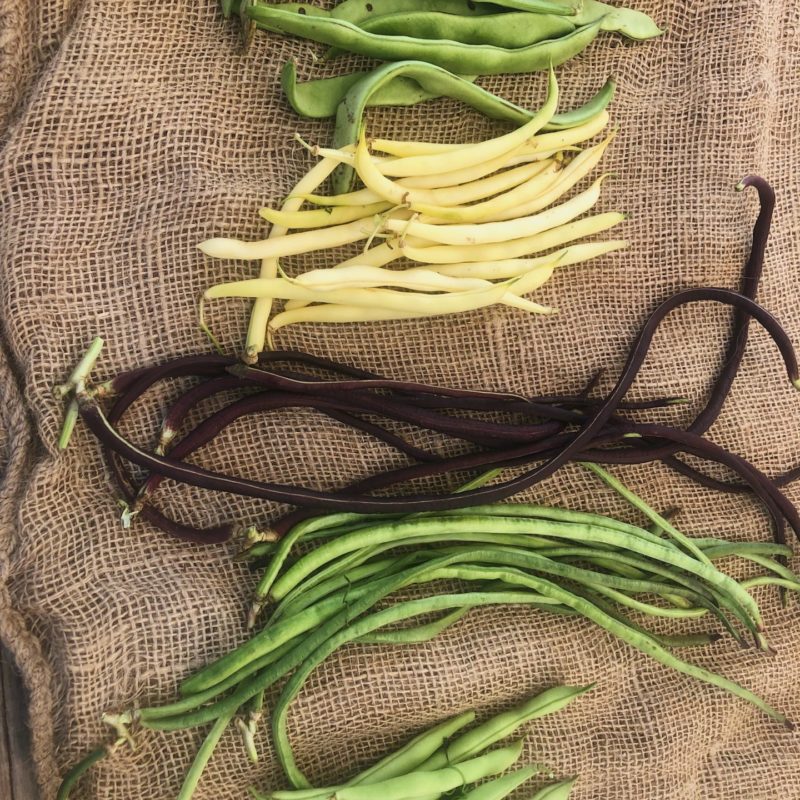The Magical Fruit

Late summer brings with it a variety of delicious beans that can be prepared and enjoyed in many different ways. From long beans to bumpy beans, purple beans to classic green beans, these seasonal delights are the perfect way to add some crunch and fiber to your next meal. This year, Farmer Frank and his hardworking crew at Crooked Sky Farms have planted many different kinds of beans for Tucson CSA members to enjoy. Before cooking your beans, prepare them by first washing and drying them, then using your fingers or a knife to remove the stem end of the bean (a great task for young ones in the kitchen!). Then, get to bean cooking.
Contender Beans
You might know Contender beans by other common names, such as green beans, French beans, string beans, or snap beans. This variety is named aptly, as it remains one of the top bean contenders among farmers, gardeners, and gourmands. These bright green beans are typically harvested when they’re about 5-6 inches long and have an earthy taste and a subtle sweetness that makes them versatile in the kitchen. For a quick and delicious side dish, blanch these beans in boiling water for a few minutes, until they’re fork-tender. Then, toss them with grated garlic, freshly squeezed lemon juice and a healthy drizzle of olive oil, salt and pepper. Right before serving, top the beans with toasted almond breadcrumbs a handful of minced parsley.
Cherokee Wax Bush Beans
In this case, the word “wax” is used to describe beans that are yellow in color. Colored yellow like the flesh of a pineapple, this string bean is beloved for its great, squeaky texture and fresh flavor. Similar in size to Contender/green beans, Cherokee Wax Bush beans are wonderful for fresh bean salads, such as niçoise salads and three bean salads. To make a lovely meal that’s perfect for warm days, serve these beans cooked alongside sliced ripe tomatoes, olives, hard-boiled eggs, boiled potatoes, and tuna (or chickpeas, for a vegetarian version). Before serving, drizzle the whole thing with a simple-yet-bright dijon vinaigrette.
Chinese Red (or Green) Noodle (Yardlong) Beans
Common in Asian cooking, Chinese Noodle, or Yardlong, beans can grow to be a few feet long and come in pretty purple and green colors. Although they look and taste similar to common string beans, Chinese Noodle Beans can become easily waterlogged and shouldn’t be steamed, boiled, or blanched. Instead, try frying these beans in hot oil to preserve their texture and taste. To make Chinese dry-fried beans, first cut the beans into two-inch pieces. Heat about a tablespoon of neutral oil in a heavy skillet over medium heat and stir fry the beans until they’re shriveled, about 6-7 minutes. Use a slotted spoon to remove the beans and set them aside. Add aromatics, such as chopped garlic, ginger, dried chiles, and scallions, to the hot skillet. Add the beans back to the skillet, along with a few dashes of soy sauce and a pinch each of salt and sugar.
Romano Beans
Romano beans are an Italian variety of string beans, closely related to the Contender and Cherokee Wax. They’re easily distinguished by their thick, flat bodies and can be colored green, yellow, or purple. Romano beans are quite sweet and snappy and can be used in any way you might use string beans or snap peas. As their wide shape makes them good dippers, try charring them on the grill and serving them with a variety of your favorite dips, kind of like an elevated crudité.
Black, Pinto, and Mayacoba Beans
Every year the farmers at Crooked Sky Farms grow black, pinto, and mayacoba beans. Rather than harvest these beans when they’re young and “fresh”, the pods are left to dry in the field until September or so, when they’re harvested and shelled. The dried beans are then stored properly so that they can be distributed throughout the year, until the next bean season comes around. Dried beans need to be cooked in water over low heat for a long period of time before they’re tender and ready to eat. Because the dried beans from Crooked Sky Farms come to us so fresh, there’s no need to soak them before cooking. Simply put them in a crock pot (or regular pot), cover them with at least a few inches of water, add some aromatics (bay leaf, dried chile, and onions work well), and simmer over low heat until they’re cooked through, adding salt just at the end of cooking.